 Italy, as a country, is already difficult to understand with regard to how it works and works pretty well. It is chaotic and full of energetic people who love the good life. In the middle of this improbable country is the impossible city of Venice. A city, built more or less in a swamp, should not function at all, let alone have been a world power just as a city for four hundred years. I love this place – it is simply magical.
Italy, as a country, is already difficult to understand with regard to how it works and works pretty well. It is chaotic and full of energetic people who love the good life. In the middle of this improbable country is the impossible city of Venice. A city, built more or less in a swamp, should not function at all, let alone have been a world power just as a city for four hundred years. I love this place – it is simply magical.
Venice may be the most romantic and photographic city in the entire world. So naturally, Genius Boy hit something when putting the camera away last night that left it with no charge in the battery, so I took no pictures on my own camera at all, all day. Not when we took the water bus to St. Mark’s square or when we toured the Doge’s Palace. Not when we took the water taxi around the eastern end of the island and then out to the beautiful small island of Burano. And certainly not as we walked back home across much of Venice, including over the famous Rialto bridge. Happily, Meredith N. took a bunch of photos and gave them to me, so Ye Olde Blog is not barren.
So, we did indeed start our day taking the twenty-minute water bus down to St. Mark’s square. The bus goes right down the entire length of the Grand Canal, so it in itself is a good way to see Venice. The plan at St. Mark’s was to spend about four hours there, touring the Venice city museum, the Doge’s Palace, and St. Mark’s itself.
The main feature of the fine square around St. Mark’s is St. Mark’s – it is an amazing church, having been built around 1100, and is well decorated inside and out. The square is huge, with fine buildings all around it, with the city museum on the opposite end from St. Mark’s. There are multiple high-end restaurants that feature live music (classical or jazz) outside as a means to draw in customers, but it also adds great ambiance to the square.
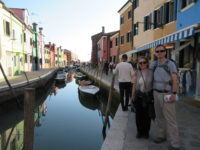 We got our museum/Doge’s Palace combination tickets in the museum, which is supposed to have short lines. In our case, there was only one group of six or eight ahead of us, but they took about five minutes to process – I have no idea why. The museum is manageable sized, meaning you can see everything in about an hour if you don’t stop to read every description card, most of which are in Italian anyway. The museum contains things you would expect from a maritime power, like globes and models of ships and maps and such, but it also showcased some of the fine rooms that were in what is now the museum. It had several hoards of coins found around Italy. It had, oddly, a very old reliquary box discovered in Turkey about 100 years ago. It also had a small but respectable archaeological museum in one wing. Following what was to be the pattern of the day, we set a meet-back time so everyone could go where they wanted to, which we did again after we met up. As such, Meredith and I spent about thirty minutes more at the museum than the others, before we moved on to the Doge’s Palace.
We got our museum/Doge’s Palace combination tickets in the museum, which is supposed to have short lines. In our case, there was only one group of six or eight ahead of us, but they took about five minutes to process – I have no idea why. The museum is manageable sized, meaning you can see everything in about an hour if you don’t stop to read every description card, most of which are in Italian anyway. The museum contains things you would expect from a maritime power, like globes and models of ships and maps and such, but it also showcased some of the fine rooms that were in what is now the museum. It had several hoards of coins found around Italy. It had, oddly, a very old reliquary box discovered in Turkey about 100 years ago. It also had a small but respectable archaeological museum in one wing. Following what was to be the pattern of the day, we set a meet-back time so everyone could go where they wanted to, which we did again after we met up. As such, Meredith and I spent about thirty minutes more at the museum than the others, before we moved on to the Doge’s Palace.
The Doge was the elected-by-peers leader of Venice when it was powerful and rich. His palace reflected that by being perhaps the most impressive display of wealth and power I have ever seen in a building, and I have been to Versailles. Everything in the palace was ornately decorated – walls, ceilings, staircases – and most of the decorations either glorified Venice or the Doge specifically. The Doge’s seat, no matter which room we were in, always was in line with some artwork depicting Jesus, usually looking down at where the Doge would sit. That includes the biggest oil painting in the world, featuring Jesus in heaven with five hundred saints surrounding him. The entire palace was designed to let you know who was in charge, and it was not you.
We toured the entire palace, and the famous Bridge of Sighs where prisoners could see the outside world through a window before being brought to the cells, which we also saw. Most of the cells had a door that you would have to stoop through to get out of, and there were holes in the walls that I guessed were used to pass food though so you would not have to open the door. Combine that with corridor doors every few dozen feet, and I have no idea how anyone would ever escape from there.
We had lunch down a tiny little alley near St. Mark’s. It was full of eateries, including some fairly aggressive waiters out front telling us how sad we would be if we did not eat at their establishment. We found an inexpensive sandwich joint, and then agreed to meet in the square around 3:00. Meredith and I headed off to explore St. Mark’s.
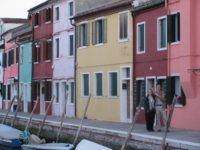 For many years, my favorite church anywhere has been St. Paul’s in London. I love the majesty and simplicity of St. Paul’s, and having services in English helps. London has competition now. St. Mark’s is visually amazing. The floors are covered in mosaics of patterns, the walls are made of different types of marble, and the ceilings are fully covered in mosaics of biblical stories and tales of the saints. The dominant color is gold – everywhere on the ceiling that is not covered with figures is all in gold tiles. It is brilliant and awe-inspiring. It was hard to know where to look (other than up).
For many years, my favorite church anywhere has been St. Paul’s in London. I love the majesty and simplicity of St. Paul’s, and having services in English helps. London has competition now. St. Mark’s is visually amazing. The floors are covered in mosaics of patterns, the walls are made of different types of marble, and the ceilings are fully covered in mosaics of biblical stories and tales of the saints. The dominant color is gold – everywhere on the ceiling that is not covered with figures is all in gold tiles. It is brilliant and awe-inspiring. It was hard to know where to look (other than up).
The only slight downside is we wandered in while the organ was being tuned, and it was the upper (piercing) register. I had never thought about an organ being tuned, but it involves playing the same note for a long time. Still, I suppose we got to hear the organ.
We wandered the main floor of the church, and then paid five euros to see the in-church museum, which takes up the balcony area. It has mosaics that were taken down in the late 1800s for a renovation, some paintings and tapestries, some huge choir books, and, most importantly, the four copper horses that used to stand on the balcony of the outside of the church. If I understood correctly. the horses were cast around the year 200, and were taken from somewhere that Venice conquered (maybe Byzantium?), and they were brought back to the church and put on display. They were moved inside the museum in the 1970s to protect them, and replicas were put outside.
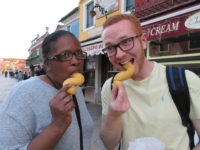 The other reason to tour the balcony is to see some of the mosaics up close. There are some that come right down to the floor in the balcony, and even the ones on the ceiling are about fifty feet closer. There is even a stone ledge to sit on, so you can stare upwards in some comfort (and without running into other people). Finally, the museum tour lets you go outside on the balcony, which overlooks the square, and even out there you get very close-up looks of some of the exterior mosaics. You can see the lagoon with all the boat traffic, and the square with all the foot traffic. The sounds of the bands playing float up to you, and you can even sit down on a ledge next to the church facade. It is quite wonderful.
The other reason to tour the balcony is to see some of the mosaics up close. There are some that come right down to the floor in the balcony, and even the ones on the ceiling are about fifty feet closer. There is even a stone ledge to sit on, so you can stare upwards in some comfort (and without running into other people). Finally, the museum tour lets you go outside on the balcony, which overlooks the square, and even out there you get very close-up looks of some of the exterior mosaics. You can see the lagoon with all the boat traffic, and the square with all the foot traffic. The sounds of the bands playing float up to you, and you can even sit down on a ledge next to the church facade. It is quite wonderful.
Our last stop in St. Mark’s was the golden altarpiece. You can pay two euros to go up front where the priest ministers from, and behind a screen, facing away from the congregation, is the elaborate altarpiece from around 1100. It is all gold, and covered in over a thousand precious stones, and it is quite large – probably six feet by twelve feet. We also got to see, close up, the standard altar with the tomb where St. Mark’s bones are kept (fun fact – while the church was being built, they forgot where they put the bones; after a public prayer service, the doge found them in a hollowed-out pillar).
We met up with the group in the square, as arranged, and walked over to the water buses. It took six of us, and asking an attendant, but we finally figured out how to get the two boats we needed to get out to one of the islands that I wanted to visit – Burano, where the people are famous for making lace. The first bus took us around the east edge of Venice, which Meredith and I had never seen. It ends in a huge park, with gardens sponsored by or inspired by various nations. It looked beautiful, and so is now on my list for my next visit to Venice. The boat ride was gentle and about forty minutes long, causing me to almost nod off and giving Jacob a chance to doze. We transferred to the next boat and rode it for another thirty minutes or so; the boat stopped briefly at the island of Murano, which is famous for glass, but we didn’t have time to get off and visit. That is also on the “next time” list.
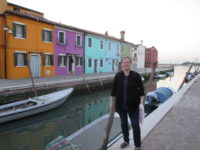 We arrived at Burano about 5:30, and not surprisingly, our route took us through a narrow shopping street. When I heard that the island made lace, I pictured endless white doilies. I was quite wrong. The Venetians made lace into dresses and scarves of all colors, and they were beautiful. If we’d had more time on the island, Meredith would have had a new wardrobe. Instead, with a little help from a restaurant that was already fully booked, we found a restaurant on the main drag, which we had accidentally wandered off of. After a leisurely meal, we again split up, agreeing to meet at 9:00.
We arrived at Burano about 5:30, and not surprisingly, our route took us through a narrow shopping street. When I heard that the island made lace, I pictured endless white doilies. I was quite wrong. The Venetians made lace into dresses and scarves of all colors, and they were beautiful. If we’d had more time on the island, Meredith would have had a new wardrobe. Instead, with a little help from a restaurant that was already fully booked, we found a restaurant on the main drag, which we had accidentally wandered off of. After a leisurely meal, we again split up, agreeing to meet at 9:00.
Burano in the evening is pure magic. The homes are all painted bright colors, and after 6:00 the vast majority of tourists go home, and the island is very quiet. Meredith, Tim, and I walked over to the local church, which has a tower that is visually leaning to one side. Toward a playground. That was being used by happy children. I assume they keep a close eye on the tower.
Tim wanted to sit in a park facing the lagoon, so Meredith and I strolled about, enjoying the quiet town. There were groups of older women talking together, and a few men puttering on boats in the small canals. We saw about ten cats, but only two were tame enough to let us pet them, and even that was warily. We were completely captivated. As darkness fell, we crossed a bridge over to the next island. It had a lighted path that went around the island, although we did not know that at the time (we found out by seeing a jogger reappear multiple times), We walked along that waterside path, eventually sitting on a bench, looking over that the fairy-light-lit town of Burano, while listening to a group of young Italian men playing soccer on a field behind us, unseen behind a high hedge. We happily sat there for about twenty-five minutes.
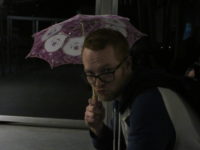 We met the others early, a little after 8:30, and about five minutes after the boat for Venice pulled out. That was fine, as we caught the next one at 9:10. The ride back in the dark was interesting, as we could only see the navigational lights dimly lighting the water behind us, as well as distant lights of the shore and the occasional boat, including a large and elegant party boat decked out as a pirate ship.
We met the others early, a little after 8:30, and about five minutes after the boat for Venice pulled out. That was fine, as we caught the next one at 9:10. The ride back in the dark was interesting, as we could only see the navigational lights dimly lighting the water behind us, as well as distant lights of the shore and the occasional boat, including a large and elegant party boat decked out as a pirate ship.
Once back in Venice, we walked back to the Grand Canal. There, Jacob said he wanted to cross the Rialto bridge and go back to the hotel a different way. We all agreed to go with him, and the trip back included a bonus stop for gelato, which kept our daily steak going. The walk back was wildly Venetian – some wide streets, crowded with people, some narrow alleys with no one around. It is all part of the package that makes Venice probably my favorite city in the word to visit.
I feel like the camera thing is a passive-aggressive swipe at me….
It’s the first time in years that I have been traveling without a camera. What a poor time for that to happen.
Some of us have cameras in these things called “cell phones”.
Yeah, those horses in St. Marks were … “acquired” after the Christian crusaders sacked Christian Constantinople because they owed Venice a _lot_ of money for financing transport to the Holy Land (which the Crusaders never got to). Pretty much killed any chance of ending the schism between the east and west churches. It’s a bit fuzzy, but I believe that Venice encouraged the crusaders to crush the Byzantine empire in order to get rid of a trading competitor. Nice stuff. Bit of dark irony that the looted-from-a-Christian-city horses are in a church.